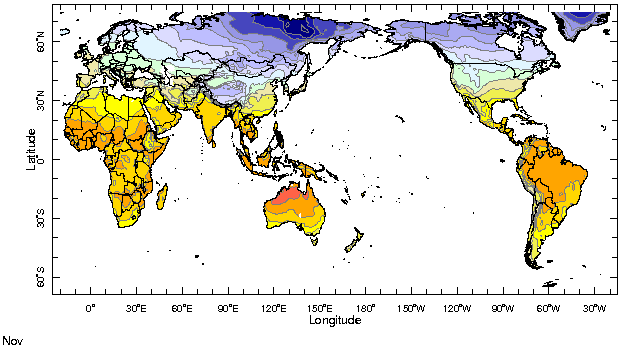|
IRI Climate Digest
December 2005
November Global Climate Summary
Climatological Background
During November, the northern hemisphere mid-latitude storm tracks increase in strength, while monsoon systems in South Africa, Australia, and South America expand southward following the maximum solar heating. Tropical storm activity decreases in the North Atlantic, the North Pacific, and northern Indian Oceans.
Monthly Mean Temperature (1961-1990), data from the Climate Research
Unit, University of East Anglia


Monthly Mean Precipitation (1961-1990), data from the Climate Research
Unit, University of East Anglia


Temperatures
The middle to high latitudes of the northern hemisphere, with the notable exception of Alaska, recorded temperatures very much above normal in November, consistent with the 3-month average picture. Temperatures were above normal in northwestern and southern sections of Africa, southeastern sections of South America, and northeastern sections of Australia. Conversely, temperatures were near or weakly below normal in a swath covering the Middle East, Central Southwest Asia and South Asia.
Temperature Difference from the 1961-1990 mean, with data
from NCEP Climate Prediction Center, CAMS.


Precipitation
Precipitation was below average in equatorial Africa, most notably along the Indian Ocean coast, and, for the third consecutive month, in equatorial South America, including the Amazon basin. Precipitation was above average in the eastern Indian-western Pacific sector, especially so in the northern hemisphere. Significant positive anomalies were observed in that region during November over peninsular India, Indochina, and the equatorial Pacific west of the dateline. In stark contrast, the Intertropical Convergence Zone in the central and eastern equatorial Pacific was characterized by negative anomalies, consistent with below-average sea surface temperatures (see Oceanic Conditions below).
Precipitation Difference from 1979-2000 mean, with data
from NCEP Climate Prediction Center, CAMS-OPI.


Oceanic Conditions
The tendency for relatively cool conditions in the eastern equatorial Pacific that was apparent in October intensified in November (see ENSO Outlook for more information). Positive anomalies in the regions of the western boundary current systems of the North Pacific and North Atlantic, also known as the Kuroshio and Gulf Stream currents, respectively, persisted but were slightly damped with respect to the previous month. Warm anomalies in the tropical North Atlantic were also reduced compared to the previous month. Significant temperature anomalies near Australia, with cooler than average conditions to the west and warmer than average to the east, seemed to strengthen in response to wind speed anomalies, which were respectively positive and negative during November.
Monthly Sea Surface Temperature Difference from the 1971-2000 mean,
with data from the Environmental Modeling Center, NCEP/NOAA.


Contents |
Special |
Impacts |
Climate |
Forecast
|

